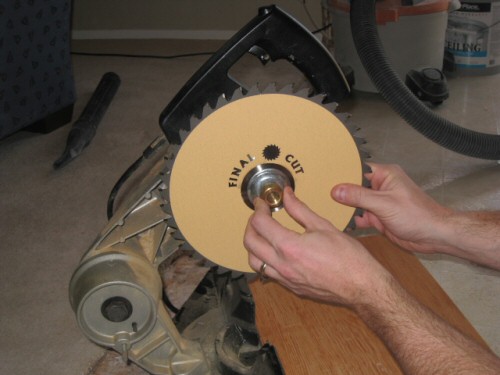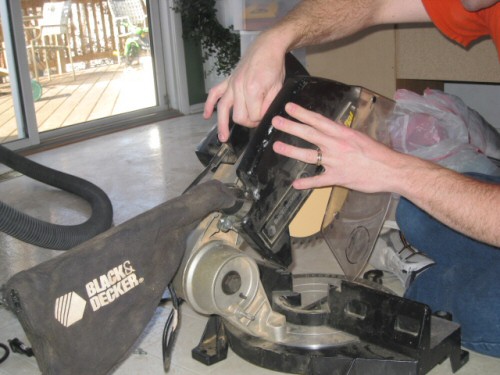
Is your saw not cutting like it used to? Don’t get rid of it! Saw blades wear out, and changing a blade on a table saw, circular saw, or mitre saw is very simple. In fact, the manufacturer intends it.
We recently employed these steps to install the Final Cut Sanding Saw Blade on an old mitre saw. The result: the saw performs just like it came off the manufacturing line.
Remember, always follow the manufacturers’ instructions for changing your saw’s blade. You may want to wear leather gloves since saw blades are, well… sharp.
Step 1: Unplug the saw. Remove the guard housing from the saw. Most saw designs make this a pretty easy task. On our mitre saw, three screws held the guard in place.
Step 2: Locate the blade lock if one exists. This will allow you to use channellocks or a wrench to remove the bolt that holds the blade in place and prevent the blade from spinning. If the saw doesn’t have a blade lock, you may have to use a piece of wood to stop the blade (see the picture below).
Note: Saw blades are held on by a reverse-thread screw and nut. This keeps the nut tight when the blade turns. Turn clockwise to loosen.
Step 3: Remove and replace the blade, and hand-tighten the nut. Make sure to replace any washers, especially a pressure-style washer against the blade.

Step 4: Use channellocks to tighten the nut. Turn counter-clockwise to tighten. Again, you may need to use a block of wood if there’s no blade lock.
Step 5: Replace the guard and ensure the guard operates correctly as you lower the saw arm.

That’s it! Really simple right? We thought so.
What do you think? Feel free to weigh in with additional tips.







Nice tutorial Fred. I’d suggest using an adjustable wrench or most saws come with a wrench. Using pliers risks stripping the nut. Also, lots of miter saws actually have a button up near the trigger, usually a small round button, when you depress that button and rotate the blade it will eventually lock the blade. It’s easier than using a scrap of wood.
Todd, concur on both points. This saw lacked the blade stop (I mentioned it for other saws in Step 2) and the channellocks where right at hand… A wrench does give you some additional assurance against stripping the nut.
Ha ! My hub could have used this post last weekend ! I always make him change the blade and he couldn’t figure out which way it went !! Took him 10 minutes !
Knowing that the blade’s nut is reverse thread will save me some trouble when I change a blade on my circular saw. Bought it used, no manual. Thanks, Fred!